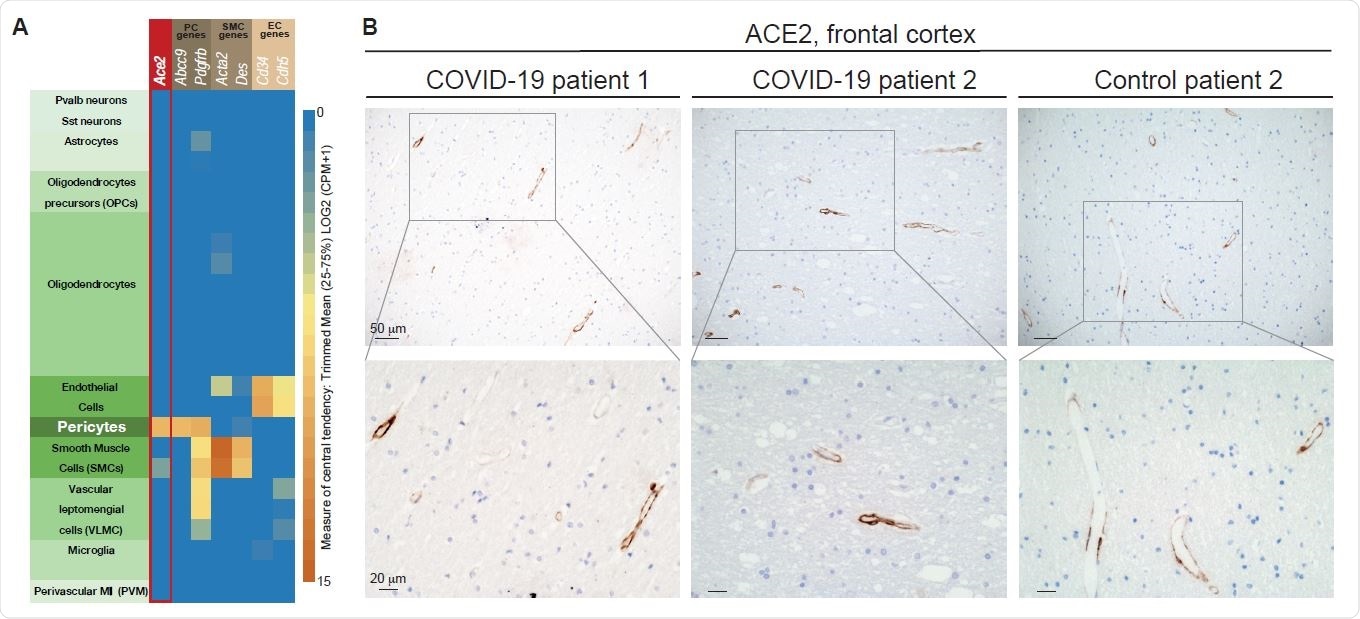Coronavirus disease 2019 (COVID-19) primarily causes respiratory symptoms that range from mild cough and fever to severe pneumonia. Increasingly, studies indicate that the severe acute respiratory syndrome coronavirus 2 (SARS-CoV-2) has an organotropism beyond the respiratory tract and that the brain is an extrapulmonary site of infection.
Central nervous system (CNS) involvement in SARS-CoV-2 involves a wide range of neurological manifestations such as headache, anosmia, fatigue, confusion, ageusia, and loss of consciousness. These symptoms often represent underlying morbidity that contributes considerably to COVID-19 mortality.
The human angiotensin-converting enzyme (ACE2) receptor, a component of the renin-angiotensin system, is the main entry point for SARS-CoV-2. However, there is no conclusive evidence about the localization of ACE2 in the human CNS, and the mechanism of brain pathology in SARS-CoV-2 infection in the brain is unclear.

Using multiplexed immunohistochemistry and spatial immunophenotyping to study the brain tissue of COVID-19 patients
Recently, researchers from the UK and Sweden used highly sensitive multiplexed immunohistochemistry to study the brain tissue of COVID-19 patients and controls to analyze ACE2 expression in brain pericytes of patients with neurological symptoms. They also used spatial immunophenotyping to assess inflammation in brain tissue of COVID-19 patients.
They applied advanced multiplexed immunostaining on six human brains from COVID-19 patients. The median age of the patients was 69.5 years. There were seven controls with a median age of 68 years. This study is published on the bioRxiv* preprint server,
Results show that patients with neurological symptoms exhibit moderate to high expression of ACE2 in peri-vascular cells
The work demonstrated that the expression of the ACE2 receptor is exclusive to a subset of brain pericytes. Interestingly, neurological symptoms were restricted to patients exhibiting moderate to high expression of ACE2 in peri-vascular cells.
Viral particles were found in the vascular wall accompanied by perivascular inflammation, as shown by T cell and macrophage infiltration. Moreover, leakage of fibrinogen suggested that the integrity of the blood-brain barrier is compromised. Cerebrospinal fluid from an additional eight COVID-19 patients with a median age of 67 years and eight controls with a median age of 69.5 years showed significantly lower levels of the pericyte marker PDGFRβ in SARS-CoV-2-infected individuals. This indicated disruption in pericyte homeostasis.
“Based on our observations, we hypothesize that infection and subsequent damage of brain vascular pericytes by SARS-CoV-2 and peri-vascular inflammation may lead to impairment of the BBB, instigating neurological complications and possibly virus entry into the CNS.”

SARS-CoV-2 infection of pericytes leads to viral entry to the central nervous system, inflammation, and neurological symptoms
The researchers concluded that pericyte infection by SARS-CoV-2 triggers entry of the virus into the privileged space central nervous system, peri-vascular inflammation leading to neurological symptoms, and compromise of the blood-brain barrier.
Interestingly, COVID-19 patients having neurological symptoms had a reduced concentration of pericyte-derived sPDGFRβ in the cerebrospinal fluid.
A likely explanation for the diminished expression of PDGFRβ in patients with COVID-19 might be that SARS-CoV-2 infection of pericytes diverts the protein synthesis system to make viral proteins. This leads to a loss of expression of an endogenous marker, resulting in functional impairment.
Better understanding of SARS-CoV-2 neurotropism is vital for the management of acute neurological symptoms in COVID-19 patients
Based on the study's findings, the researchers propose that ACE2-expressing pericytes can be a possible site of SARS-CoV-2 entry into the CNS. According to the authors, a better understanding of SARS-CoV-2 neurotropism is needed in order to guide the management of acute neurological symptoms in COVID-19 patients. It will also help define strategies that can prevent post-COVID-19 neurological complications.
Further studies are needed to confirm if interventions aiming at supporting the integrity of the blood-brain barrier would help alleviate the neurological symptoms in patients with COVID-19.
“An improved understanding of SARS-CoV-2 neurotropism is urgently needed to guide the clinical management of acute neurological symptoms, as well as to define strategies to prevent post-infectious neurological complications.”
*Important Notice
bioRxiv publishes preliminary scientific reports that are not peer-reviewed and, therefore, should not be regarded as conclusive, guide clinical practice/health-related behavior, or treated as established information.
- Infection of brain pericytes underlying neuropathology of COVID-19 patients, Matteo Bocci, Clara Oudenaarden, Xavier Sàenz-Sardà, Joel Simrén, Arvid Edén, Jonas Sjölund, Christina Möller, Magnus Gisslén, Henrik Zetterberg, Elisabet Englund, Kristian Pietras, bioRxiv, 2021.05.24.445532; doi: https://doi.org/10.1101/2021.05.24.445532, https://www.biorxiv.org/content/10.1101/2021.05.24.445532v1
Posted in: Medical Research News | Medical Condition News | Disease/Infection News
Tags: ACE2, Angiotensin, Anosmia, Blood, Brain, Cell, Central Nervous System, Coronavirus, Coronavirus Disease COVID-19, Cortex, Cough, Enzyme, Fatigue, Fever, Headache, IHC, Immunohistochemistry, Immunophenotyping, Inflammation, Macrophage, Mortality, Nervous System, Pathology, Pericytes, Pneumonia, Protein, Protein Synthesis, Receptor, Renin, Respiratory, SARS, SARS-CoV-2, Severe Acute Respiratory, Severe Acute Respiratory Syndrome, Syndrome, Vascular, Virus

Written by
Susha Cheriyedath
Susha has a Bachelor of Science (B.Sc.) degree in Chemistry and Master of Science (M.Sc) degree in Biochemistry from the University of Calicut, India. She always had a keen interest in medical and health science. As part of her masters degree, she specialized in Biochemistry, with an emphasis on Microbiology, Physiology, Biotechnology, and Nutrition. In her spare time, she loves to cook up a storm in the kitchen with her super-messy baking experiments.
Source: Read Full Article
